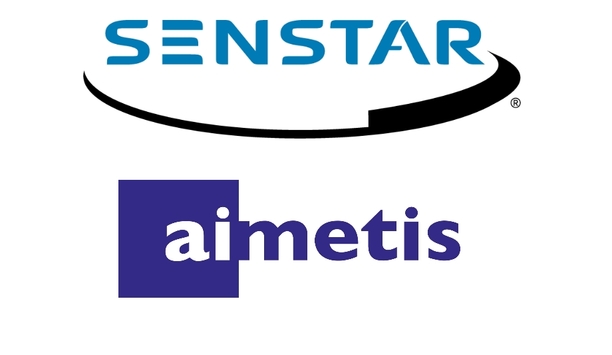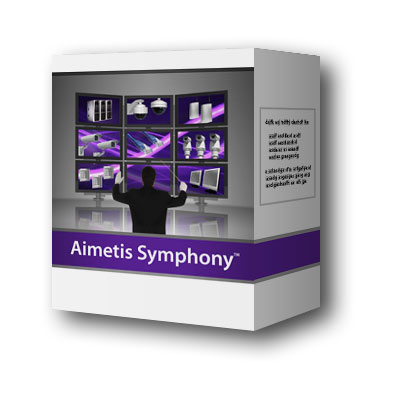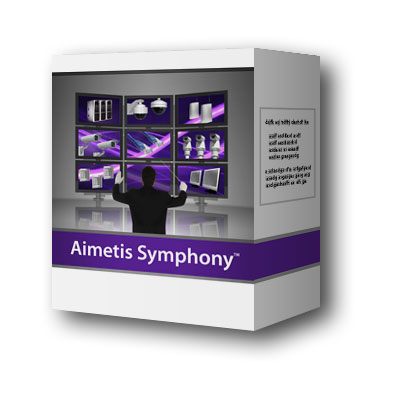Aimetis - Experts & Thought Leaders
Latest Aimetis news & announcements
Senstar and Aimetis, a Senstar company, showcases perimeter intrusion detection and video management solutions at Security 2018. New products, including the Security Innovation Award finalist Senstar LM100 hybrid perimeter intrusion detection and intelligent lighting system, and Senstar Symphony 7.1 video management software, were on display at Booth 5C09. “Since the last Security show we have introduced exciting new products and have been working hard to transition Aimetis to the Senstar brand,” said Senstar’s VP of Sales – EMEA Fabien Haubert. “We look forward to demonstrating how bringing together the world’s largest portfolio of perimeter intrusion detection products and world-class video management software creates intelligent, integrated security solutions that provide true value for our customers.” Implement video analytics Products on display includes: The Senstar LM100 combines two key security functions in one cutting-edge product, acting as a powerful deterrent against intruders by detecting and illuminating them at the fence line. The Senstar LM100 is one of 13 finalists from 75 entries for the prestigious Security Innovation Awards to be presented at the show. Senstar Symphony 7.1 is the new benchmark for intelligent video management software (VMS) allowing for control of an entire video surveillance system Senstar Symphony 7.1 is the new benchmark for intelligent video management software (VMS) allowing for control of an entire video surveillance system from one central location. Users can connect and configure cameras, monitor open spaces, implement video analytics, and use centralized cloud management tools for multi-site management. Intelligent surveillance system Symphony Analytics are ideal for businesses searching for a more efficient and intelligent surveillance system. License Plate Recognition – track, record and report vehicle license plates. Face Recognition – identify known and unknown individuals. Outdoor Object Tracker – classify people and vehicles, filtering objects by size and location FlexZone is a cable-based fence-mounted system that detects and locates any attempt to cut, climb or otherwise break through the fence. FlexZone adapts to most fence types and is ideal for sites of all sizes. Thin Client is a PC alternative designed to easily display 1080p video from 30+ network video manufacturers, as well as digital signage. Its easy setup and compact design are ideal for space constrained environments. For live demonstrations of the above products and others, visit Senstar at Security 2018 Booth 5C09.
Senstar has announced the beginning of a transition period to bring Aimetis under the Senstar brand. Senstar, a provider of perimeter intrusion detection systems (PIDS), acquired Aimetis, a provider of video management systems (VMS) and analytics, in April 2016. Since then, the two companies have worked in parallel to continue to provide PIDS and VMS solutions. However, over the coming months, Senstar and Aimetis will become one company, resulting in reduced complexity, improved performance, and unified support. Combining PIDS with VMS “Bringing together the PIDS expertise of Senstar with the VMS and analytics knowledge of Aimetis enables us to offer an unrivalled range of innovative security solutions and world-class support,” said Senstar President Brian Rich. “Throughout the transition period we are committed to ensuring as little disruption as possible to our business. Our customers and partners can expect the same accessible, responsive and flexible sales and support they have always relied on, and to be well-informed regarding any changes that may affect them.” The combination of PIDS and VMS addresses a growing trend in the security industry to reduce complexity by enabling customers and partners to source comprehensive security solutions from a single provider, resulting in reduced costs and greater accountability. Network Manager integration Senstar is also pleased to introduce the integration of its Network Manager alarm reporting system and Symphony VMS (formerly Aimetis). Network Manager is a software gateway that allows communication with a wide array of Senstar sensors, including FlexZone®, FiberPatrol®, OmniTrax®, and UltraWave™. Symphony, the new benchmark for intelligent video management, is an ideal software solution for recording, monitoring and analysing video from both single server installations and multi-server deployments. The integration enables Symphony to receive the full range of alarm and status information from Senstar sensors via an IP connection. For each sensor alarm the full range of Symphony’s security responses can be initiated, including commanding camera actions and providing visual and audio alerts.
At Intersec 2017, Promise will introduce Vess A6120, a complete 1U 4-bay product line After record growth in the Middle East and North Africa (MENA) region in 2016, Promise Technology returns to Intersec 2017 in Dubai with the company’s largest and most exciting display ever. Promise will be joined at its booth by 17 ecosystem partners, showcasing countless integration possibilities and new technologies which will be highlighted in the Promise Presentation Theatre. Additionally, the strong growth in the MENA region has led to the development of several new solutions on display from Promise, including the upcoming Auryn surveillance storage block, Vess A6120 1U 4-bay server appliance, and the Vess A3340 NVR with dual power supply units (PSU).Auryn surveillance storage blockAt Intersec 2017, Promise will introduce Vess A6120, a complete 1U 4-bay product line with a management server, analytics server, and recording server. Additionally, Promise will introduce Auryn, a new high-capacity surveillance storage block designed to meet the needs of the MENA region which has some of the longest retention times in the world. Auryn is a simple way to deploy a whole storage block and is ideal for deployments requiring a large centralised storage solution which offers an open-platform, simplicity, optimisation, and the industry’s most comprehensive partner ecosystem. Additionally, Promise will debut the Vess A3340 with dual PSUs, a key feature in applications where power supply redundancy is necessary.Promise Presentation TheatreIntersec’s most popular tradeshow seminar, the Promise Presentation Theatre, is back with more exciting topics covered by the industry’s top companies and influencers. Intersec attendees are invited to visit the Promise display to learn more about the trends shaping the industry and after every presentation Promise will be giving away a fantastic prize to one of the visitors.Partner ecosystem "Intersec Dubai is a great platform for Promise to showcase why we are the preferred server and storage developer for the video surveillance industry” 17 companies will be joining the Promise partner showcase at Intersec, including Aimetis, Allied Telesis, Axis, AxxonSoft, Bosch, C-Link, Digifort, Hanhwa Techwin, Intelligent Security Systems (ISS), Ipsotek, IronYun, Milestone, NEC, Securitas, SeeTec, Toshiba, and Trassir. The top companies responsible for the most exciting innovations in the security industry in areas such as video management software (VMS), IP cameras, video analytics and hard disk drives will showcase their solutions along with Promise’s servers and storage solutions in interactive demonstrations."Intersec Dubai is a great platform for Promise to showcase why we are the preferred server and storage developer for the video surveillance industry,” said John van den Elzen, General Manager, Surveillance Business Unit, Promise Technology. "We are really looking forward to working together with all of our partners at Intersec as we will showcase our complete range of Vess NVRs and external storage solutions and also offer a look at some exciting new solutions that we will be launching soon.”For more information, please visit Promise at booth SA-C26 at the Dubai International Convention and Exhibition Centre during Intersec from January 22nd – 24th, 2017.
Insights & Opinions from thought leaders at Aimetis
With the current state of economic uncertainty, there is a huge opportunity in 2017 for perimeter intrusion detection (PID) manufacturers to reach the commercial market. Petty crime rates, such as theft and vandalism, are on the rise and, as a result, small business owners are looking for new security options to enhance their current camera and alarm systems. Often thought of as complicated, expensive, and only for high-value applications, PID has a chance to change its perception in the years ahead. The winners in this space will be security companies who can provide simple and reliable products at the right price point. Impact of 2016 Presidential election Presidential elections in the United States are of great importance to the security industry, with many companies trying to anticipate early on what the impact will be and to plan accordingly. The 2016 election was particularly interesting because of the extensive security and international trade narratives propagated by Donald Trump. Looking to 2017, with Trump taking office, the industry awaits news about if and when he will implement the measures he spoke about in his campaign. For Senstar, the aforementioned commercial PIDs opportunities will be a big focus for 2017. As well, we will continue to work to holistically integrate our new video/IVA capabilities with our PID products to offer our customers comprehensive perimeter security solutions. Convergence and growth in 2016 Our predictions for the year 2016 were fairly accurate as the convergence of physical and cyber security continued and several low-cost radar solutions were developed and launched to address drones. In terms of the video/IVA market, which we correctly predicted would continue to grow in 2016, Senstar added video capabilities to our portfolio by acquiring Aimetis, a world-class video analytics and management company. Senstar is now poised to offer customers even more options for securing critical assets and infrastructure. One prediction that failed to materialise was an increased demand for fibre optic-based sensors. Sales in that space remained flat as potential customers for these products looked to more cost-effective copper-based solutions. See the full coverage of 2016/2017 Review and Forecast articles here
Environmental implications are important considerations in surveillance system designs Rising energy costs are compelling many organisations to optimise their computing environments. In fact, energy costs have quickly become the fastest growing operating cost, propelling many corporations to embark on new conservation and "green" initiatives. Marc Holtenhoff, CEO of Aimetis, explores ways to reduce energy consumption within video surveillance applications, that could pave the way for a ‘green' security industry. Fortunately, green Information Technology (IT) not only helps the planet but reduces operational pressure. Green IT becomes even more important when video surveillance is taken into consideration. With the recent proliferation of CCTV systems, energy consumption from video surveillance has increased dramatically, resulting in higher total cost of ownership. However, as video surveillance transitions from proprietary "black box" DVR deployments towards IP deployments using commercial-off-the-shelf hardware, video surveillance becomes both greener and leaner. Video surveillance energy consumption is largely attributed to the electrical power required to operate the video servers that are running the security cameras and storing vast amounts of recorded video data. However, electrical power usage is not a typical design criterion for CCTV, nor is it properly managed as an expense. This is likely because the billed electrical costs are not clearly linked to CCTV, and the electrical bill is not within the responsibility or the budget of the security group. Electrical power consumption in CCTV With the recent proliferation of CCTV systems, energy consumption from video surveillance has increased dramatically The fact that most CCTV deployments today make inefficient use of the energy they consume is hardly a surprise. With industry research estimates that more than 50 percent of the energy used in the server room goes to power and cooling equipment rather than computations and processing, the true costs of running excess servers and storage are not well understood. Using IP surveillance solutions to reduce energy consumption With the above in mind, it goes without saying that when deploying a video surveillance system best efforts should be taken to reduce the number of servers required. This makes sense not only for the environment, but also for the pocket book. To this point, IP surveillance offers clear advantages over analogue CCTV or DVR deployments with significant savings as a result of sharing existing network infrastructure, computation and storage. IP surveillance software plays an important role in helping to reduce the hardware footprint. Here are eight factors that contribute to a positive environmental and operational impact with IP surveillance software. IP surveillance offers clear advantages over analogue CCTV or DVR deployments with significant savings Camera density per server With CCTV deployments, typical security camera density ranges from 4 to 32 channels per DVR, and come in increments of 4 or 8 channels. Consequently, numerous physical servers are necessary since the total number of cameras exceeds one server. With IP video surveillance software, more than 200 surveillance cameras can be managed and recorded using a single, energy efficient server, which normally takes 2U of rack space (about half the typical rack space of a single 16 channel DVR). Take an example of a 70-camera deployment. In this scenario, three 4U DVRs can be replaced by one, industry-standard 2U server running Windows and video surveillance software. Consequently, energy consumption is reduced by more than $1000 per year when factoring savings from fewer servers and less cooling requirements. Better still, vital rack space is returned and re-usable for other projects. Virtualisation One of the reasons that energy costs spiral can be found in the "one-to-one-to-one" hardware approach, where each server hosts only one operating system that, in turn, runs a single application. Not only are these environments expensive, but they also promote IT inefficiency, because multiple servers operate at a fraction of their computing capacity. This under-utilisation scenario is typical with deployments using DVRs. For example, supporting nine surveillance cameras may require the use of two 8-channel DVRs. However, both DVRs are typically operating with a CPU load of less than 10 percent. Most CCTV deployments today make inefficient use of the energy they consume This "one-to-one-to-one" hardware approach also unnecessarily increases software maintenance and support due to the sheer number of physical servers requiring software patches or hardware maintenance. Worse still, the risk of data loss is significant since not only is the cost of purchasing numerous back-up servers prohibitive, but the additional required rack space is non-existent, and the additional 400W of electricity required to support them further adds to operating costs and carbon emissions. With virtualisation technology, organisations can consolidate servers and easily reduce IT power requirements. A virtualised IT environment also dramatically decreases IT administration costs. For example, with only one physical server instead of two, server BIOS updates are cut in half, backups and disaster recovery becomes a fraction of the cost with fewer physical servers to protect and network ports are relinquished with fewer physical servers requiring connectivity to the network. Typical analogue and DVR CCTV deployments cannot leverage the excess computing and storage capacity that virtualisation provides due to their proprietary nature. Conversely, a surveillance solution that uses open IP video management software product running on commercial-off-the-shelf hardware is able to benefit from virtualised computing environments, provided the video management software supports virtualisation technology. As a result, IP surveillance is not only better for the environment but substantially lowers costs. With virtualisation technology, organisations can consolidate servers and easily reduce IT power requirements Video analytics and reduced video storage Video analytics can play a sizeable role in reducing video storage requirements by only recording when relevant activity occurs. This, in turn, reduces space and energy requirements. It should also be noted that video analytics are significantly more accurate at detecting relevant activity than video motion detection (VMD), which means less storage is wasted for false events. In a typical surveillance environment not using video analytics for event-based recording, the amount of storage required for 16 cameras, storing 24 fps at 640x480 resolution for 7 days using MPEG-4 is about 20GB per camera. Studies have shown in a difficult outdoor environment that using video analytics enabled results in storage savings of more than 50% as compared to DVRs using VMD. With video analytics, video recordings caused by irrelevant background noise is greatly reduced, resulting in less disk space required for the same 7-day period. Better still, video analytics also reduces rack space and electricity dedicated for storage. Unfortunately, in many cases video analytics is supplied by a different vendor than what was used for video recording. By adding an additional piece of hardware for analytics, which runs parallel to the existing recording product (such as a DVR or NVR), it undermines the green IT strategy by duplicating unnecessary hardware. By using a single software product for both video management and video analytics, users are able to take full advantage of the cost-saving benefits without the corresponding server increase for running analytics. Saving money via IP video surveillance is a welcome change from the pervasive mindset that green initiatives must be costly Video compression with H.264 H.264 is the preferred video encoding compression standard capable of providing good video quality at substantially lower bit rates than previous standards. H.264 represents a 50% reduction in bandwidth and storage over MPEG-4 and an 80% reduction over MJPEG, which reduce hardware, space and power requirements. Green licensing Most video surveillance software vendors offer different license versions depending on surveillance requirements. The problem is that more often than not, the different software versions are unable to run on the same server. Users should ensure that each of the available license versions can be mixed and matched on a single server. This means that the end-user can choose to run analytics on selected surveillance cameras, and standard video management software on other cameras without the need to add additional servers. Power over Ethernet Power over Ethernet (PoE) is a technology for wired Ethernet local-area networks that allows the electrical current necessary for the operation of each device to be carried by the data cables rather than by power cords. This minimises the number of wires that must be strung in order to install the network. The result is lower cost, less downtime, easier maintenance and greater installation flexibility than with traditional wiring. Additionally, using PoE it is possible to provide the data required for network software to reduce enterprise energy consumption with better power allocation and management. A recent study found that digital delivery reduced total tons of carbon emissions by 88% Remote surveillance and monitoring Remote surveillance is an effective tool for eliminating unnecessary driving or flying to verify security alarms and track job-site progress. Consider a construction site that will often deploy cameras to protect against raw material theft. With video analytics, remote monitoring personnel can be notified of suspicious activity (e.g. perimeter breach) and verify the security alarm before sending a guard, or police to drive to the site. The same argument applies for corporate facility security as well. Online distribution A recent study found that digital delivery reduced total tons of carbon emissions by 88%. The elimination of transportation and packaging provides the greatest opportunity for carbon emissions reduction. By making products available online via digital download, vendors can eliminate nearly 100% of the carbon emissions associated with transportation, as shipping is not required. Additionally, without the need for packaging, online software distribution eliminates carbon emissions. Additionally, remote surveillance can be used in place of management driving or flying to job-sites to track job-site progress. To put the benefit of remote surveillance into perspective, eliminating just one 50-mile drive, or one three-hour flight saves 88.2 and 1543 lbs. of carbon dioxide emissions, respectively. Approaches to green security aren't costly Incorporating the above mentioned eight approaches will enable you to both reduce energy consumption and the environmental impact. And saving money via IP video surveillance is a welcome change from the pervasive mindset that green initiatives must be costly. In fact, you can be both greener and leaner. Marc HoltenhoffCEO of Aimetis
Palm vein recognition
DownloadThe key to unlocking K12 school safety grants
DownloadPhysical access control
Download5 surprising findings from OT vulnerability assessments
DownloadHoneywell GARD USB threat report 2024
DownloadAimetis announces Aimetis E3200 physical security appliance: Video management, analytics and business intelligence in all-in-one network appliance
Aimetis launches Symphony™ Version 6.5, which offers enhanced scalability, availability and updated video analytics
Aimetis Symphony: Video management and video analytics in harmony
















